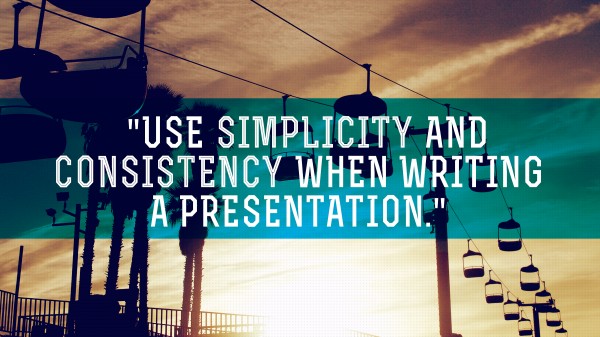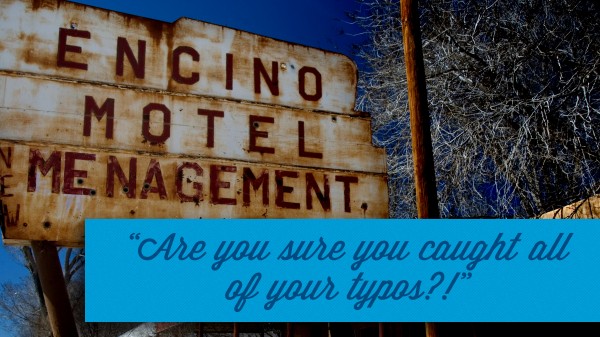“Writing is easy. Just sit down and open a vein.” – Red Barber
Did you know that “writer’s block” technically didn’t exist until the 1900s? There is no mention of the word before that time, and even then, it didn’t come into popular use until the 1940’s. We know that writing a presentation is difficult. But don’t let the probably-fictitious writer’s block prevent you from starting a masterpiece.
We offer a lot of different information about creating presentation content, from using specific style rules (like the Rule of Three) to some tools that you can use to draft presentations. However, this post will focus on creating a first draft from the ground up; for presenters who are approaching content for the first time. Whether it’s a business pitch, a school presentation, a business report, or even a lecture for the pulpit, start here when you are ready to sit down and destroy the whole world with the power of your message. Maybe. No promises.
Gather Information
This is the sleuth-detective phase of writing and probably one of the easiest. Use a program like Evernote to gather notes, or consider going off the grid. Avoiding “laptop tan” means finding inspiration outside of the chaos of Facebook notifications and random Google Searches. No matter how you approach this process, start by asking yourself:
Who is the audience? – This will give you an idea of what kind of tone to use, and if incorporating “jargon” is allowed. How knowledgeable will they be about your topic? Can you get away with using humor, or should you stick to the facts? Understanding your audience is the best place to start crafting your content.
How long will the presentation need to be? – 15 minutes, an hour? Do you have room to stretch out the content and share a story, or should you keep things short and sweet?
What are your main points? – This will be the skeleton of your content. Why are you giving this talk, and what information do you have to share? If you find that you have too much information, start weeding out anything that isn’t essential.
What do you want the audience to walk away knowing? – This is perhaps the most important question of all. What is the point? Why are you going to stand in front of an audience and talk? If possible, try to limit this to one concept or fact. That way your content can lead to the culmination of this question.
On a scale of 1-10, how creative do you want this presentation to be? – This is something you should keep in the back of your mind as you write. Will metaphors be okay? How about personal stories? (We recommend those!) This preliminary question can help keep your content concise throughout.
By the time these questions have been thought through, you may find that you have a little novel inside of you rather than a presentation. But control yourself! Focus on the presentation first, you overachiever!
Decide on a Theme
“What separates a powerful theme from the concepts and opinions above is that it takes a stand. A great theme tells people how to act and does so with authority: Embrace change! Be Strong! Destroy Evil!” – Cliff Daigle
Before writing your first draft, decide on a word, a phrase, or just a title that captures the essence of that “main idea” we discussed in the last section. For example, maybe you are pitching your rubber-less tire invention to a group of investors. The theme could be “Forward,” which is a word you could pepper throughout your deck.
Why a theme? We use them at Ethos3 to help let clients know before the deck is written that we have a precise creative vision in mind. It’s sort of like a “Main Point Lite,” and has the power to share a feeling or idea rather than a factual statement like “rubber-less tires are going to be so helpful for everyone.”
Takeaways
Now we are getting to the skeleton of your content’s structure. The takeaways are the strong backbone that will carry the weight of your message, and should be decided on before the first draft is written. We recommend keeping them short, only using a few (three or less, if possible), and making sure they are memorable.
Keeping your theme in mind, write out three takeaways that support your main idea. Still unsure about what that looks like? We have a whole blog post dedicated to it.
What if you don’t have any facts to support a main idea? What if your main point is simply to make the audience think a little harder about global warming or puppies? Takeaways can alternatively be known as “memorable bits.” Consider replacing supporting facts with a personal story; they will be more memorable than data, we promise.
Laying Out Slides
We use Apple’s Pages to lay out our slides before they are designed, but in all seriousness, you could use a sheet of paper with some squares drawn on them to prepare your presentation. Decide on a slide count based on your gut, the length of your talk, or a lucky number to start. Number your slides and be sure to include room outside of the “main box” for notes/scribbles on the side.
We are advocates for more slides, less data. For example, a 50-slide deck usually doesn’t make our clients bat an eyelash; beautiful design occurs with simplistic slides that have one point at a time on them rather than a billion bullet points. That’s what’s known as a Presentation Revolution, son.
Writing
“Don’t take anyone’s writing advice too seriously.” – Lev Grossman
The boxes are waiting to be filled. Your audience awaits. Now is your time to shine like a shooting star on a moonless night. Fortunately for you, most of the work is done already. You have your takeaways, you’ve decided on a theme, you know what you want your audience to walk away knowing, and you know your audience backwards and forwards. Keep these in mind as you craft your content:
Simplicity – Your slides exist to support your spoken message, not to distract. Don’t put a lot of content on the slides. For instance, an entire paragraph that your audience will be reading while you prattle on.
Consistency – Don’t stray from your core theme and style. For example, don’t insert a knock knock joke when you’ve established a corporate theme.
Poetry – If you’re having a hard time keeping the text on screen minimal, consider approaching your presentation like a poem. We’ve developed a 5-7-5 technique that can keep the text waaay down on your slides, which might be helpful if you haven’t written or delivered many presentations before.
Drink a lot of coffee and forget about editing while you write; that can come later. In fact, try to avoid going back and instead focusing on keeping a natural flow through the process. You can tear yourself apart afterwards! Read on to learn more about that, in fact!
Total Destruction AKA Editing
“When your story is ready for rewrite, cut it to the bone. Get rid of every ounce of excess fat. This is going to hurt; revising a story down to the bare essentials is always a little like murdering children, but it must be done.”- Stephen King
The first draft might not be perfect. It will probably stink. But it can help you better understand the jumble in your head and start to sort out some of the questions you’ve answered earlier. Curious to know how many drafts we’ve gone through before one presentation was approved at Ethos3? Our record is 7. That’s 7 different revisions to one presentation, 7 times editing, 7 rounds of fresh ideas. And you know what? We all survived.
Editing is the delicate and time-consuming part of writing a presentation. One of the most complete guides to editing that exist was created by the University of Pennsylvania, which includes a whole boatload of grammatical tips help to guide your way. If you have any friends, family, or coworkers who are willing to endure it, a proofreader can help you catch mistakes.
How do we edit at Ethos3? Many, many pairs of eyes. Spell check can’t catch stupidity, so it’s important to either revisit your own work later with “fresh eyes” or enlist someone else to help you.
The Finished Product
“Prowling about the rooms, sitting down, getting up, stirring the fire, looking out the window, teasing my hair, sitting down to write, writing nothing, writing something and tearing it up…” – Charles Dickens
We can commiserate with you; writing a presentation is difficult. And even after the content has been laid out, edited down to a perfect size, and completely expresses what you want the audience to walk away knowing…it’s not quite done yet. You now must move onto presentation design, which is an entirely different subject.
Conduct a follow-up questionnaire to see whether or not you have reached your content goals throughout the presentation. Ask:
Was my main point clear?
Will the audience know all of the terms I’m using?
Will the presentation be easy to follow while speaking?
Is it memorable?
Are there any horrible typos or mistakes?
By this point, we are confident that you’ve created something that your audience will remember. Even if you are just using the proper form of “your” or “you’re,” the content is probably better than most that exist in this cruel, grammarless time. Pat yourself on the back: you wrote a presentation.


